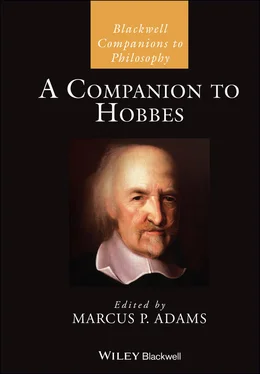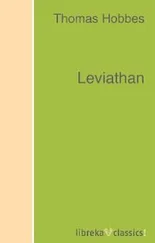These two appeals to, and explicit citations of, geometrical principles are clear (these both provide the “why”), but if this is supposed to be a mixed mathematics explanation where are the appeals to experience (the “that”)? Foundational to the discussion of the visual line and the optic axis are two claims to which anyone with everyday visual experiences would agree: first, sometimes an object’s apparent location is different from its actual location; and second, to view objects that are moving or are very large, human perceivers must move their eyes and, sometimes, their head, to perceive well. These two claims, which arise from everyday experience, are the “that,” and the two principles from geometry provide the “why.” 10
4.3 Hobbesian Natural Philosophy: Sense in De Corpore XXV
Hobbes had a keen interest in understanding human sensation, especially since he held that all ideas began in whole or in part in sense. His discussion of sense in Leviathan 1 is well known, but Hobbes himself states that what he offers there is not so much an explanation on its own but rather has been provided to prevent there being a gap in the account offered in Leviathan :
To know the cause of naturall Sense, is not very necessary to the business now in hand; and I have written else-where of the same at large. Nevertheless, to fill each part of my present method, I will deliver the same in this place.
(2012, 22; 1651, 3)
Hobbes may have had Elements of Law in mind with this reference to what had been “written else-where,” or perhaps he had the explanation offered in De corpore XXV that would be published later (as Malcolm notes; see 2012, 23 fn. a). Regardless, the explanation that Hobbes provides in De corpore XXV will be the focus of this section because, just as in the case from De homine examined above, in that chapter Hobbes provides an explicit citation to a principle from geometry as well as to two principles from first philosophy, the latter of which underwrite exchanging equivalent terms. The importance of this explanation in De corpore chapter XXV is clear since Hobbes opens Part IV of that work (“Of Physics, or the Phenomena of Nature”) with it, and Hobbes emphasizes the significance of understanding the nature of “appearing itself” before one can understand nature’s appearances (OL I.316).
Hobbes’s explanation of sense in De corpore XXV is in a series of steps, beginning as follows: 11
1 All sensation is a mutation of a sentient body;
2 All mutation is either motion or endeavor, but endeavor is also motion;
3 Therefore, all sensation is motion of a sentient body (derived from 1 and 2).
4 The motion of any body A occurs only by means of some other body B, which is contiguous to A and presses upon A; and
5 Therefore, all sensation occurs by contiguous bodies pressing upon a sentient body, i.e., the organs of sense, which motion continues in the sentient body (derived from 3 and 4).
The first step of this explanation, I suggest, is known from the everyday experiences of human perceivers (the “that” of the explanation). Hobbes describes this as something that we can “observe” as we consider the character of our own experiences, claiming that we “observe that our phantasms are not always the same, but new ones are constantly being created and old ones are disappearing, just as the organs of sense are turned now to one, now to another object. Therefore, they are produced and pass away, from which it is understood that they are some mutation of the sentient body ” (OL I.317; emphasis added). As objects enter and depart our visual field, we have different phantasms, or conceptions, that result from those objects and from this any human perceiver will recognize that throughout the process of any act of sensation their body changes in response to stimuli, i.e., as their body senses it undergoes mutation.
Next, Hobbes provides a citation to his first philosophy from earlier in De corpore , which allows him to exchange the term “mutation” with “motion”: “But that all mutation is something having been moved or endeavoured, (which endeavour is also motion) in the internal parts of the thing changed has been shown ([in De corpore ] cap. 9., art. 9.)” (OL I.317). This definitional linkage provides Hobbes with the ability to move to the third step above, namely, that all sensation will be motion in the sentient body, or, as Hobbes puts it: “sensation in the sentient can be nothing other than motion of some of the parts inside the sentient, which moved parts are parts of the organs by which we sense” (OL I.317).
Step four likewise incorporates a borrowed principle from first philosophy in De corpore IX.7: “it has been shown ([in De corpore ] cap. 9., art 7.) that motion cannot be generated except by [some body] moved and contiguous. From which the immediate cause of sensation is understood to be in this, that it both touches and presses the first organ of sense” (OL I.318). This principle requiring body–body contiguity rules out the possibility of sensation by action at a distance. However, so far Hobbes has explained only motion from objects that enters the eye; recall the discussion above of Hobbes’s optics regarding the motion from the retina outward . In earlier works and in De corpore XXV, Hobbes recognized a need to explain why human perceivers see objects as outside them rather than seeing them as inside them, since internal motions partly constitute sensation. The reason why humans perceive bodies as outside them, Hobbes posited, is due to an outward endeavor that results from bodily resistance to the pressure from outside.
This outward resistance, which explains us taking objects of perception to be outside of us and not mere fancy, was part of Hobbes’s early optics. For example, he notes in Minute that “this fancie, though it bee butt a motion within Yet because the motion tendeth outward by reaction it appeareth to us to bee without and not a motion, but that thing which wee call light” (1983, 334). In De corpore , Hobbes similarly claims, after noting that he has “almost defined what sense may be” (OL I.318), that perception of external objects as external to us is due to an outward endeavor: “Likewise, it has been shown ([in De corpore ] cap. 15., art. 2.) that all resistance is the endeavor contrary to [another] endeavor, that is, reaction” (OL I.318). Although the explanans (resistance tending outward) is the same between Minute of 1646 and De corpore of 1655, in the latter work Hobbes gains the ability to appeal directly to his geometry from De corpore , and this is exactly what he does. With this last step of the explanation in place (this last step is the “why” of the explanation), Hobbes can define “sense” as “a phantasm made by means of a reaction from an endeavor to [the] outside, which is generated by an internal endeavor from the object, and there remains for some time” (OL I.319).
This borrowing of the causal principle related to endeavor and reaction outward does not constitute a claim by Hobbes of how bodies actually act. As he emphasizes at several points in De corpore , the aim of natural philosophy is to provide possible causes. Instead, this borrowing of a principle from geometry provides a possible cause to explain why bodies appear to perceivers as outside them. This provides the natural philosopher with the ability to say that if this causal principle describes how the parts of the bodies of human perceivers behave, then the consequence (sensation) would necessarily follow.
Читать дальше












